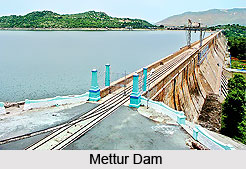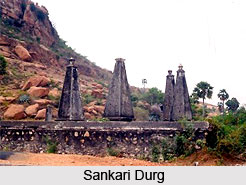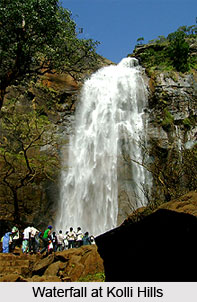 Visiting places around Salem reflect the nature at it best. Salem district is a beautiful place in the Indian state Tamil Nadu with many important visiting places around it. Some of them are:
Visiting places around Salem reflect the nature at it best. Salem district is a beautiful place in the Indian state Tamil Nadu with many important visiting places around it. Some of them are:
Mettur Dam
Mettur is a dam in Tamil Nadu, which is situated about 30 kms from Salem. Mettur Dam was constructed in a gorge where the Kaveri River enters the plains. It has a height of 65 metre, length 1616 metre, area 15,540 hectare and capacity 2648 cubic metre. This is a hydro-electric power station, which produces 240 mega watt powers.
There is also a beautifully decorated garden. Large number of factories can be seen here including those of soaps and detergent manufacturing factories, galvanizing plants, Vanaspathi units etc. The tourists can see them with proper permit. The visitors can also enter the tunnel of the Mettur Dam and see the hydroelectric power station after taking proper permission.
Belur
This place is 25 kms away from Salem on the banks of river Vashistanadhi. The white rock north of Belur is said to represent the ashes of the Yagam (Sacrificial fire) performed by Vashista.
Kolli Hills
This hill station is situated at an altitude of 1190 mts. One can see fruit orchards around this place. The tribes of this hill station near Salem are still unchanged and follow strictly their traditional customs and practices.
Namakkal District
It was earlier a part of Salem District. Now, it is the headquarters of the newly formed district Namakkal. Here, the Hanuman statue is 20 ft high, which is carved out of single piece of rock. The two unique cave temples here are the works of Adhia rulers containing relief sculptures of unrivalled beauty. These are dedicated to Narasimha and Anantasayi.
Tharamangalam
 This place is said to be the paradise to lovers of sculpture. The dance competition between Lord Shiva and Goddess Kali is depicted in the Kailasanathar temple here. These two sculptures depict the episode in such a lively way that one can feel as if it is happening in front of the eyes. The sculpture of Bikshadana, arihpatni is another wonders here.
This place is said to be the paradise to lovers of sculpture. The dance competition between Lord Shiva and Goddess Kali is depicted in the Kailasanathar temple here. These two sculptures depict the episode in such a lively way that one can feel as if it is happening in front of the eyes. The sculpture of Bikshadana, arihpatni is another wonders here.
Thiruchengodu
This place is situated in the southwest of the Salem district and an important shrine dedicated to Ardhanariswarar. It is situated at a height of 2000 feet. There are flights of winding steps, which lead to the temple. There is huge hooded serpent sculpture along the steps by the side, which looks very real and frightening. A huge Nandi stands facing the hill assuming it to be Lord Shiva. The Maladi hill is situated above the hill. Infertile women crawl around it three times to be blessed with pregnancy.
Sankari Durg
This place is popular for Someswar temple, which attracts lots of devotees. There is a boulder similar to one at Maladi hills, which is about 40ft. high and almost equally broad. A well known cement factory is also there since limestone is enormously found here.
Dharmapuri
It was earlier a part of Salem district but now its headquarters. It was called Thagadur during the Sangam Age and was the capital of Adiaman Neduman Anji. The main attraction here is a 7 ft high Hanuman in the temple of Anna Sagaram. The curious feature about this Hanuman is that he has no tail at all.
Hogenakkal
Hogenakkal is a place in Dharmapuri, where the Cauvery River enters Tamil Nadu. It is regarded as the chief picnic spot in Dharmapuri. This most beautiful place in the state of Tamil Nadu is full of picturesque scenes.
 At this point in Hogenakkal, the broad stream of the river Kaveri gets forked. It forms an island from where one stream continues and plunges into a deep gorge to create a lovely waterfall. The spray of this waterfall raises clouds of droplets, which looks like a smoke, hence this place is known as Hogenakkal (Hoge means smoke and Kal means rock) i, e, smoking rock.
At this point in Hogenakkal, the broad stream of the river Kaveri gets forked. It forms an island from where one stream continues and plunges into a deep gorge to create a lovely waterfall. The spray of this waterfall raises clouds of droplets, which looks like a smoke, hence this place is known as Hogenakkal (Hoge means smoke and Kal means rock) i, e, smoking rock.
The Kaveri River flows in a particular narrow gorge so narrow that it could be easily leapt by a goat. Therefore, that place in Hogenakkal is called Meka Dhattu (Goat`s leap). Taking a bath in this fall is considered good for health as the water of Cauvery flows through a herbal forest before it reaches Hogenakkal. So, numerous people come here everyday to have bath in river.
The parisal is a round basket like boats, which are availed by the visitors to feel the thrill of adventure in the river here in Hogenakkal. It is a perfect holiday spot and one can take the best of it by taking long walks and treks.
Hosur
Hosur is very well known as a centre of industries. It is also a tourist centre. Thali located near this place is known as `Little England` to the British due to its beautiful green downs and healthy climate.



















